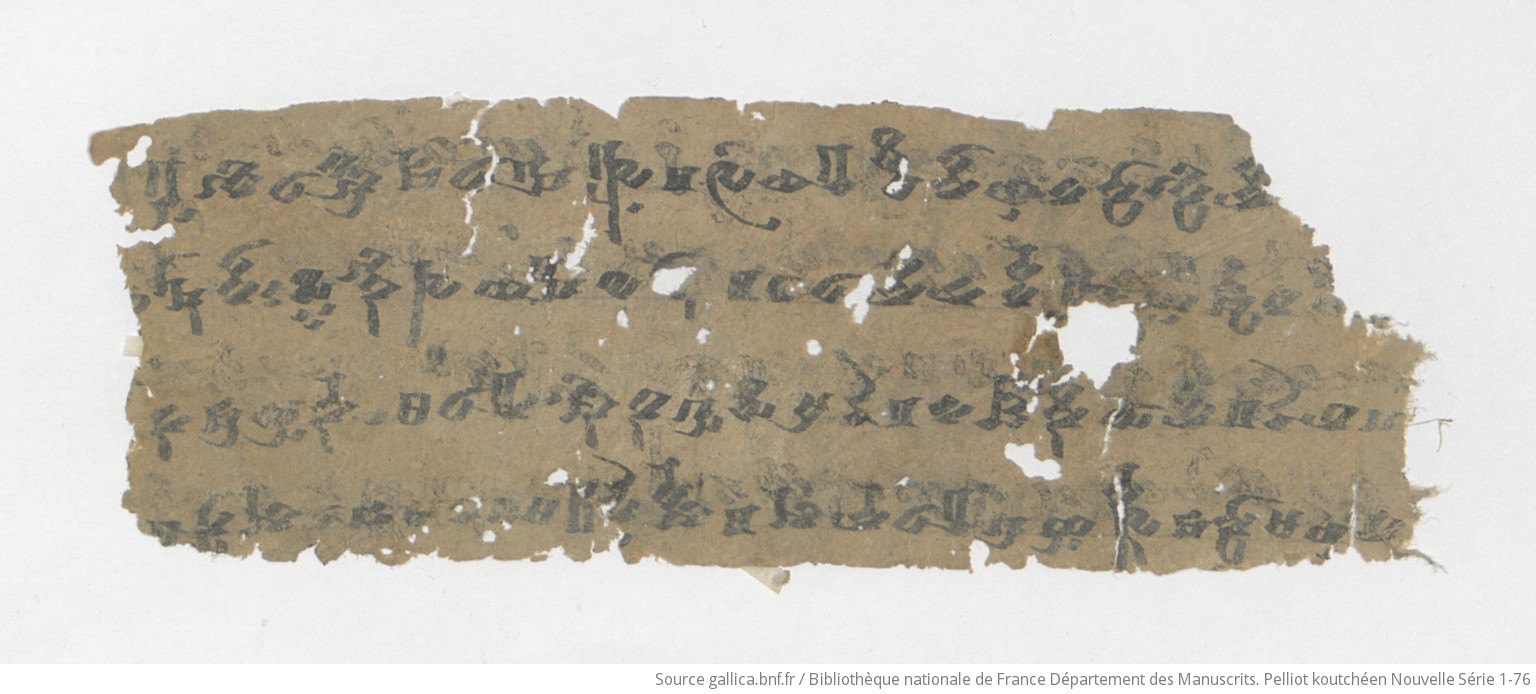Work in progress
PK NS 2
| Known as: | PK NS 2; Pelliot Koutchéen Nouvelle Série 2 |
|---|
| Cite this page as: | Georges-Jean Pinault; Hannes A. Fellner (collaborator). "PK NS 2". In A Comprehensive Edition of Tocharian Manuscripts (CEToM). Created and maintained by Melanie Malzahn, Martin Braun, Hannes A. Fellner, and Bernhard Koller. https://cetom.univie.ac.at/?m-pkns2 (accessed 05 Jul. 2025). |
|---|
Edition |
| Editor: | Georges-Jean Pinault; Hannes A. Fellner (collaborator) |
|---|
| Date of online publication: | 2014-08 |
|---|
Provenience |
| Main find spot: | Subashi |
|---|
| Collection: | Bibliothèque nationale de France, fonds Pelliot Koutchéen (Paris) |
|---|
Language and Script |
| Language: | TA |
|---|
| Script: | classical |
|---|
Text contents |
| Text genre: | Literary |
|---|
| Text subgenre: | Medicine/Magic |
|---|
| Verse/Prose: | prose; verse |
|---|
Object |
| Manuscript: | PK NS 1-6 |
|---|
| Material: |
ink
on paper |
|---|
| Form: | Poṭhī |
|---|
| Size (h × w): | 5.4 × 15.3 cm |
|---|
| Number of lines: | 4 |
|---|
| Interline spacing: | 1.4 cm |
|---|
Images
Transliteration
| a1 | /// ·w· tsi pa¯ ¯t yo ktsi pa¯ ¯t ke ne e¯ ¯s̝ a ka lyme ma ska traṃ sa¯ ¯m |
|---|
| a2 | /// kā¯ ¯ts ku ñci¯ ¯t dha nya mā¯ ¯s̝ pi ppa la¯ ¯s : ā ra gva¯ ¯t• : śā ñca po • ko sne |
|---|
| a3 | /// s̝a pu¯ ¯k ta pre nä¯ ¯k sa sa¯ ¯k• ku ṣtaṃ pa¯ ¯r to sa¯ ¯s pu kywā rtri wä s̝a¯ ¯l ke [n]· |
|---|
| a4 | /// śwā tsyaṃ yo ktsyaṃ pa¯ ¯t e¯ ¯s̝ sa¯ ¯m u nma tte ma ska tra : ku pre ne pa ltskā lu tka s[s]i |
|---|
| b1 | /// tā s̝aṃ śa kri ma lke yo pā rya¯ ¯l kā su ma ska traṃ || sa¯ ¯s da śa m·¯ ¯l su tri¯ ¯s |
|---|
| b2 | /// pa cā¯ ¯r pa tā ñä kte a na pa¯ ¯r śā ñca po ne sse tya¯ ¯l 20-1 ke ño mā ne |
|---|
| b3 | /// ¯ñc ca mi yä lya tka nā knā¯ ¯l ca[¯] [¯]m [ṣñi] wa ṣta¯ ¯s̝ lu tse ñcäṃ : ku ppre n· |
|---|
| b4 | /// knā tsi kri na s̝aṃ ku tka rya¯ ¯s̝ o ma lyāṃ ṣpa¯ ¯l mu snā¯ ¯l tsa ryo |
|---|
Transcription
Translation
| a1 | The one to whom ones gives ... to eat or to drink, this one becomes under ones control. |
|---|
| a1+ | With that one ... |
|---|
| a2 | sesame, mung bean, long pepper, cassia fistula, Dalbergia sissoo. |
|---|
| a2+ | As much as everything is (available), as much indeed a single (person) pours it in ...-wise. |
|---|
| a3 | One should mix together all these (ingredients). |
|---|
| a3+ | To whom one gives that in the food or in the drink, this one becomes insane. |
|---|
| a4+ | If to return with the mind one wishes, one should make a recitation (?) with milk containing sugar. |
|---|
| b1 | It is good for him. |
|---|
| b1+ | Of the Daśamālā-sūtra this is the treatment. |
|---|
| b2 | In front of the Buddha (statue) one should cast a spell on the Dalbergia sissoo 21. |
|---|
| b2+ | In whose name they make [it], the (Dalbergia sissoo) has to be strewn over the earth that is expected to be walked on by him. |
|---|
| b3 | [Then] they expel him from his own house. |
|---|
| b3+ | In case that one has the wish to pull out (a spike?) one should rise a hot pill from ... with the hand. |
|---|
Commentary
Remarks
| * | This is an almost complete leaf with few akṣaras missing on the left side. By comparison with the lines of the leaf PK NS 1 there is one - maximal two - akṣaras missing at the beginning of the lines a3 and a4, b1 and b2. The general disposition is worse than in the leaf PK NS 1. There are traces of horizontal ruling, but there is no place reserved for the string hole which is between lines 2 and 3. The script is less formal than in the average TA manuscripts. Recto and verso can not be securely ascertained because of the absence of a leaf number at the left margin. On the recto side there many traces of imprints from akṣaras of another leaf. |
|---|
Linguistic commentary
| n1 | The form taṃpar seems to be an adverb comparable to keṃ-par 'perversely' based on a noun taṃ. |
|---|
| n3 | The word pār can be identified with TB pār 'recitation', a loan from Skt. pātha-. |
|---|
Philological commentary
| n2 | The segmentation after the verb kuṣ is not entirely certain. |
|---|
References
other
Couvreur 1956: 97-98
Bibliography
Couvreur 1956
Couvreur, Walter. 1956. “Bemerkungen zu Pavel Pouchas Thesaurus linguae tocharicae dialecti A.” La Nouvelle Clio 7-8, 1955-56: 67–98.




